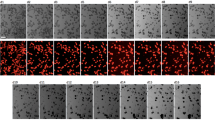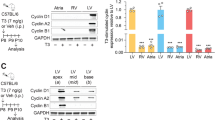Abstract
The reactivation of an embryonic pattern of gene expression is a central feature common to virtually all forms of cardiac hypertrophy. Unraveling the regulatory mechanisms, growth factors and cytokines controlling gene expression and cell fate during cardiac development may therefore have implications for our understanding of cardiac hypertrophy in the adult. Along this line, a cDNA expression library was established from an embryonic stem cell-based in vitro model of cardiogenesis, and screened for clones that would induce an increase in cell size in cultured cardiomyocytes. This experimental strategy resulted in the isolation of a novel cytokine, cardiotrophin-1 (CT-1), that activates several features of cardiomyocyte hypertrophy in vitro, including sarcomeric organization and embryonic gene expression. CT-1 displays structural similarities to the interleukin (IL)-6 related cytokines. Furthermore, receptor binding studies and functional studies reveal that CT-1 shares the signal transducing receptor components gp130 and LIFR with the previously identified members of the IL-6 cytokine family. CT-1 rapidly activates gp130 and LIFR tyrosine phosphorylation in cultured cardiac myocytes. The growth promoting effects of CT-1 therefore indicate that signaling pathways emanating from gp130 and LIFR are coupled to cardiomyocyte hypertrophy. In support of this notion, the simultaneous overexpression of IL-6 and the IL-6 receptor in transgenic mice has been shown to result in a constitutive tyrosine phosphorylation of gp130 in the myocardium and cardiac hypertrophy. The striking phenotype of gp130 null-mutant mice, generated by homologous recombination, implies gp130 in cardiac development as well: mutant mice exhibit severe ventricular hypoplasia, suggesting a role for gp130-dependent signaling pathways in the expansion of the compact layer of the ventricular myocardium. CT-1 is expressed at high levels in the myocardium during the course of cardiogenesis, and promotes the proliferation and survival of embryonic cardiomyocytes. CT-1 may therefore represent a candidate cytokine to activate gp130 during cardiac development. In summary, cytokines signaling through gp130 are emerging as potent regulators of embryonic heart development and adult cardiac hypertrophy.
Similar content being viewed by others
Author information
Authors and Affiliations
Additional information
Received: 1 January 1997 / Accepted: 14 March 1997
Rights and permissions
About this article
Cite this article
Wollert, K., Chien, K. Cardiotrophin-1 and the role of gp130-dependent signaling pathways in cardiac growth and development. J Mol Med 75, 492–501 (1997). https://doi.org/10.1007/s001090050134
Issue Date:
DOI: https://doi.org/10.1007/s001090050134




